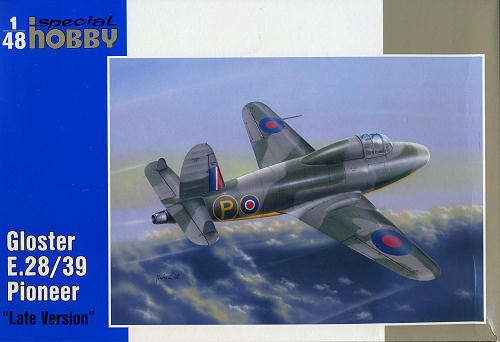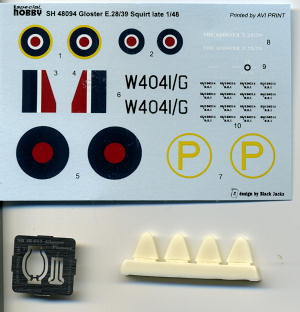
| KIT #: | SH48094 |
| PRICE: | $39.00 MSRP ($33.25 from www.greatmodels.com ) |
| DECALS: | Two Options |
| REVIEWER: | Scott Van Aken |
| NOTES: | Short run with photo-etch and resin parts |

| HISTORY |
The Gloster E.28/39, (also referred to as the "Gloster Whittle", "Gloster Pioneer", or "Gloster G.40") was the first British jet engined aircraft to fly. Developed to test the new Whittle jet engine in flight, the test results would influence the development of an operational fighter, the Gloster Meteor.
Although the initial flight tests were seemingly early in the Second World War, the Germans were one stage ahead, having first tested their Heinkel He 178 at 6 am on 27 August 1939, days before the start of the war itself at Rostock-Marienehe on the Baltic Coast, piloted by Erich Warsitz.
The aircraft was delivered to Hucclecote for ground tests beginning on 7 April 1941 using a non-flightworthy version of the Power Jets W.1 engine. These include some short "hops" of about 6 ft in height from Brockworth's grass airfield. With these initial tests satisfactorily completed, the aircraft was fitted with the flightworthy new engine rated for 10 hours use and transferred to Cranwell which had a long runway. On 15 May 1941, Gloster's chief test pilot, Flight Lieutenant Gerry Sayer flew the aircraft under jet power for the first time from RAF Cranwell, near Sleaford in Lincolnshire. The flight lasted 17 minutes and was a complete success.
Tests continued with increasingly refined versions of the engine over the following months. Later in the test program, small, auxiliary fins were added near the tips of the tailplanes to provide additional stability in high-speed flight. Though the second prototype was destroyed early in testing, the initial prototype is still extant in the British Science Museum.
| THE KIT |
 Molded
on two grey sprues with one clear sprue for the canopy, the detailing on
this new Special Hobby kit is first rate. A small Eduard photo etch fret is
included that contains parts for the nose wheel gear. A resin sprue is also
included for the small finlets that are attached to the tailplanes for the
final version of the aircraft.
Molded
on two grey sprues with one clear sprue for the canopy, the detailing on
this new Special Hobby kit is first rate. A small Eduard photo etch fret is
included that contains parts for the nose wheel gear. A resin sprue is also
included for the small finlets that are attached to the tailplanes for the
final version of the aircraft.
As this is a research plane (though
it was originally to be armed), there are not a ton of parts. What is there
is very well done. The cockpit consists of a tub that you build up and there
is a nice raised detail instrument panel. I do wish that SH had at least
included an etched harness, though since the canopy is one piece, perhaps it
was felt it wasn't needed. It was
 as the
canopy is quite clear.
as the
canopy is quite clear.
Aside from the cockpit, the most complex part of the build will be the landing gear. This has, for the main gear, separate lower sections where the wheel is attached. It would have been nice to have at least one side of the gear fork molded to the main strut for additional strength, but perhaps it won't be an issue. The nose will require a hefty 30 grams of weight and since the intake is just a plug, there will be plenty of room for it atop the nose gear well piece.
The instructions have but four main steps with various smaller drawings to assist with alignment and parts placement. There are markings for two planes (actually, two versions of one plane). They differ only in that one has the finlets and the other has the Gloster name on the nose. Both are in RAF Dark Green/Ocean Grey over Yellow. The Aviaprint decal sheet is well done and should work superbly.
| CONCLUSIONS |
This looks like not only a simple kit to build, but one that won't take up a ton of shelf space. Anyone doing prototypes or who wants something to go along with their Condor He-178, will find this one to be a great choice.
| REFERENCES |
http://en.wikipedia.org/wiki/Gloster_E.28/39
You can find this and many other fine kits and accessories at GreatModels
If you would like your product reviewed fairly and quickly, please contact me or see other details in the Note to Contributors.